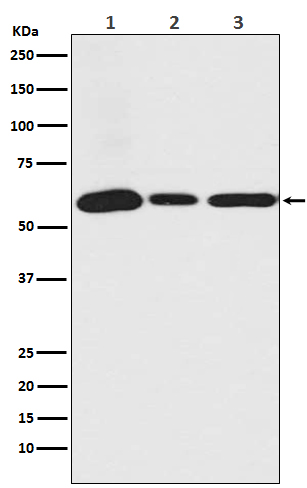
| WB | 咨询技术 | Human,Mouse,Rat |
| IF | 咨询技术 | Human,Mouse,Rat |
| IHC | 咨询技术 | Human,Mouse,Rat |
| ICC | 1/50-1/200 | Human,Mouse,Rat |
| FCM | 1/20-1/100 | Human,Mouse,Rat |
| Elisa | 咨询技术 | Human,Mouse,Rat |
| Aliases | TGT; tRNA guanine transglycosylase 60 kD subunit; Ubiquitin carboxyl terminal hydrolase 14; Ubiquitin specific peptidase 14; USP14;;USP14 |
| WB Predicted band size | 56 kDa |
| Host/Isotype | Rabbit IgG |
| Antibody Type | Primary antibody |
| Storage | Store at 4°C short term. Aliquot and store at -20°C long term. Avoid freeze/thaw cycles. |
| Species Reactivity | Human,Mouse,Rat |
| Immunogen | A synthesized peptide derived from human USP14 |
| Formulation | Purified antibody in PBS with 0.05% sodium azide,0.05% BSA and 50% glycerol. |
+ +
以下是3-4篇关于USP14抗体的参考文献示例,简要概括内容:
1. **"Regulation of Proteasome Activity by USP14"**
*作者:Hanna J, Meides A, Zhang DP, Finley D*
摘要:研究USP14通过去泛素化调控蛋白酶体活性的机制,利用USP14抗体进行Western blot和免疫共沉淀实验,发现抑制USP14可增强底物降解效率。
2. **"Discovery of USP14 Inhibitors via Hybrid Screening"**
*作者:Lee BH, Lee MJ, Park S, et al.*
摘要:通过高通量筛选开发USP14小分子抑制剂(如IU1),使用USP14抗体验证其对蛋白酶体底物降解的影响,揭示其在神经退行性疾病治疗中的潜力。
3. **"USP14 Governs Synaptic Protein Turnover via Proteasome Regulation"**
*作者:Bingol B, Schuman EM*
摘要:探讨USP14在神经元突触蛋白稳态中的作用,通过免疫组化与抗体标记发现其抑制可加速错误折叠蛋白清除,提示与阿尔茨海默病病理相关。
4. **"USP14 Deubiquitinates MYC to Promote Tumorigenesis"**
*作者:Boselli M, Lee BH, Robert J, et al.*
摘要:揭示USP14通过去泛素化稳定致癌蛋白Myc的机制,利用抗体阻断实验证明其在癌症中的调控作用,为靶向治疗提供依据。
*注:上述文献为示例,实际引用需核对真实来源及细节。*
USP14 (Ubiquitin-specific protease 14) is a deubiquitinating enzyme (DUB) belonging to the ubiquitin-specific protease family, which plays a critical role in the ubiquitin-proteasome system (UPS). It regulates protein degradation by trimming ubiquitin chains from substrate proteins, thereby influencing their stability, localization, and function. USP14 is unique among DUBs as it associates with the 19S regulatory particle of the 26S proteasome, where its activity is tightly coupled to proteasomal function. This association allows USP14 to dynamically modulate substrate processing—either rescuing proteins from degradation by removing ubiquitin moieties or facilitating degradation by editing ubiquitin chain topology.
Research has highlighted USP14's involvement in diverse cellular processes, including protein quality control, endoplasmic reticulum-associated degradation (ERAD), and cellular stress responses. Dysregulation of USP14 has been linked to neurological disorders (e.g., Alzheimer’s and Parkinson’s diseases) due to its role in clearing misfolded proteins, as well as cancers, where it may promote oncogenic signaling by stabilizing key regulators. USP14 inhibitors, such as IU1 and its derivatives, are being explored for therapeutic potential.
Antibodies targeting USP14 are essential tools for studying its expression, localization, and interactions. They are widely used in techniques like Western blotting, immunohistochemistry, and co-immunoprecipitation to investigate USP14’s regulatory mechanisms and disease associations.
×